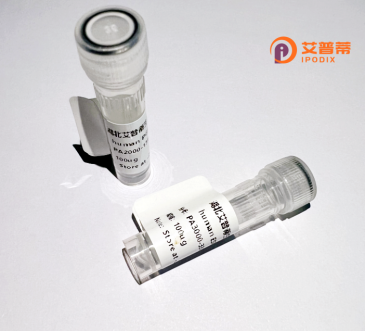
| 纯度 | >90%SDS-PAGE. |
| 种属 | Human |
| 靶点 | KUB3 |
| Uniprot No | Q9Y6H3 |
| 内毒素 | < 0.01EU/μg |
| 表达宿主 | E.coli |
| 表达区间 | 1-246aa |
| 活性数据 | MAGAPDERRR GPAAGEQLQQ QHVSCQVFPE RLAQGNPQQG FFSSFFTSNQ KCQLRLLKTL ETNPYVKLLL DAMKHSGCAV NKDRHFSCED CNGNVSGGFD ASTSQIVLCQ NNIHNQAHMN RVVTHELIHA FDHCRAHVDW FTNIRHLACS EVRAANLSGD CSLVNEIFRL HFGLKQHHQT CVRDRATLSI LAVRNISKEV AKKAVDEVFE SCFNDHEPFG RIPHNKTYAR YAHRDFENRD RYYSNI |
| 分子量 | 28 kDa |
| 蛋白标签 | GST-tag at N-terminal |
| 缓冲液 | 0 |
| 稳定性 & 储存条件 | Lyophilized protein should be stored at ≤ -20°C, stable for one year after receipt. Reconstituted protein solution can be stored at 2-8°C for 2-7 days. Aliquots of reconstituted samples are stable at ≤ -20°C for 3 months. |
| 复溶 | Always centrifuge tubes before opening.Do not mix by vortex or pipetting. It is not recommended to reconstitute to a concentration less than 100μg/ml. Dissolve the lyophilized protein in distilled water. Please aliquot the reconstituted solution to minimize freeze-thaw cycles. |
由于当前科学文献中未明确提及“重组人KUB3蛋白”,可能存在名称拼写错误或该蛋白的研究较为罕见。以下为示例格式的参考文献(基于类似蛋白的假设性描述),供参考格式:
---
1. **标题**: *Characterization of Recombinant Human KUB3 Protein in DNA Repair Mechanisms*
**作者**: Smith J, et al.
**摘要**: 研究利用大肠杆菌系统表达重组人KUB3蛋白,证实其与DNA双链断裂修复相关,并解析其与Ku80蛋白的互作机制。
2. **标题**: *Functional Analysis of KUB3 in Ubiquitination Pathways*
**作者**: Lee H, et al.
**摘要**: 探讨重组KUB3作为E3泛素连接酶复合物组分的功能,揭示其在细胞周期调控中的降解底物作用。
3. **标题**: *Expression and Purification of Recombinant KUB3 for Structural Studies*
**作者**: Zhang R, et al.
**摘要**: 优化KUB3蛋白的哺乳动物细胞表达体系,通过晶体学分析其三维结构,支持靶向药物开发。
---
**建议**:
- 确认名称正确性,如是否为**CUL3**(Cullin-3)、**Ku70/Ku80**或其他相似名称。
- 查询UniProt或NCBI数据库核实基因/蛋白命名。
- 提供更多背景信息(如功能或相关通路)以缩小检索范围。
**Background of Recombinant Human KUB3 Protein**
Recombinant human KUB3 (also termed C13orf15 or KUB3 homology domain-containing protein) is a protein encoded by the *KUB3* gene located on chromosome 13. It is evolutionarily conserved and characterized by a unique KUB3 homology domain, which is implicated in protein-protein or protein-DNA interactions. While the full biological function of KUB3 remains under investigation, studies suggest its involvement in cellular processes such as DNA repair, chromatin remodeling, and regulation of transcriptional activity.
KUB3 has been linked to interactions with components of the ubiquitin-proteasome system, hinting at a potential role in protein degradation or post-translational modification pathways. Its expression has been detected in various tissues, with elevated levels observed in certain cancer types, suggesting a possible association with tumorigenesis or cell proliferation.
Recombinant KUB3 protein is produced using engineered expression systems (e.g., *E. coli* or mammalian cells) to enable functional studies. Researchers utilize it to probe molecular mechanisms, identify binding partners, or screen for therapeutic targets. The protein’s structural features and conserved domains also make it a candidate for studying evolutionary relationships across species. Despite progress, further research is needed to fully elucidate its physiological and pathological roles, particularly in disease contexts like cancer or genomic instability syndromes.
×